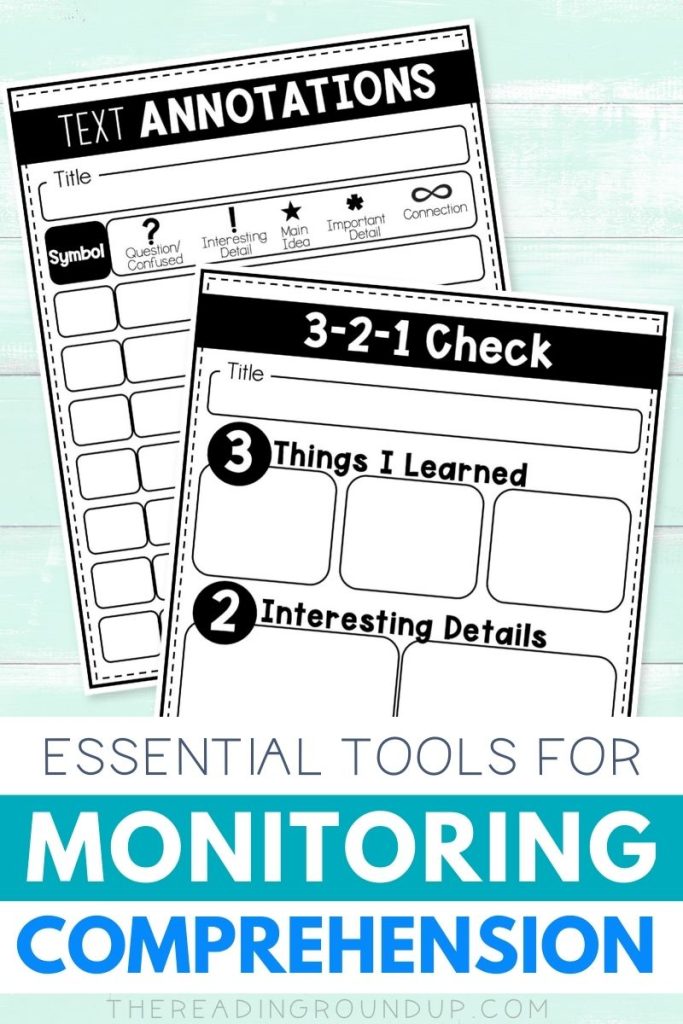
The monitoring comprehension strategy is one of the first skills that students need to learn. Reading is thinking, so we need to teach them to actively monitor and clarify their understanding as they read. These tools will help you get started with this strategy!
What is Monitoring Comprehension?
Monitoring comprehension means actively engaging with the text to ensure we comprehend what we are reading. This requires us to have an awareness of when our understanding breaks down and be able to implement fix-up strategies to improve our comprehension.
How to Teach the Monitoring Comprehension Strategy
These helpful teacher tips and resources will help you teach the monitoring comprehension strategy. These essential tools will make teaching students to actively monitor and clarify their comprehension much easier for you and more effective for your students. Not only will they be successful with a challenging skill but they’ll also have fun!
Monitoring Comprehension Tools
When teaching reading strategies, such as monitoring comprehension, there are some essential tools we always need. These teaching materials include mentor texts, anchor charts, and graphic organizers.
Monitoring Comprehension Mentor Texts
When teaching students to monitor and clarify their comprehension, nonfiction texts tend to work the best. When students lack the necessary background knowledge to access the text, they will be confused and need more clarification. If you plan to use fiction text for this strategy, you’ll want to find stories with a complex plot. Check out some specific Monitor and Clarify texts you may want to use with students.
Monitor and Clarify Anchor Chart
Displaying a Monitor and Clarify Anchor Chart can remind students of fix up strategies they can use when their comprehension breaks down.
Ideally we want readers to recognize when something doesn’t make sense and work to clarify understanding.

Questions to Check Reading Comprehension
Students may not automatically recognize when they do not understand the text. As a result, we may need to ask questions to help them check their reading comprehension.
- Is there a word or phrase you found confusing?
- Do you have any background knowledge about this topic?
- What questions do you have about what you read?
- What can you do when you come to a confusing part?
Monitoring Comprehension Graphic Organizer
Some students may need graphic organizers to structure their thinking. They can record their thinking on a graphic organizer as they read during small groups, literacy centers, or small groups. These graphic organizers can be for metacognitive strategies such as predicting, summarizing, questioning, or making connections.

A 3-2-1 graphic organizer is another way to help students actively monitor their comprehension as they are reading.
Save time by creating a Reading Graphic Organizers file box to keep at your small group table. That way you always have copies ready for students to practice the skill!
Readers’ Notebook Page and Study Guide
A readers’ notebook page can remind students of the strategy, graphic organizer, and sentence stems to use when using the monitoring comprehension strategy.
Print a copy that they can use for additional practice at home.

Fix Up Strategies Bookmark

Students can keep a Reading Bookmark in their book boxes to remind them of the monitoring comprehension strategy during independent reading.
Monitoring Comprehension Activities
While these tools are all scaffolds for students as they learn how to Monitor and Clarify their understanding, you may be looking for more specific activities to teach the skill. Be sure to check out the corresponding post with Monitoring Comprehension Activities that your students will love!
Save yourself time and money with this Comprehension Bundle! It includes ALL the tools you need for EVERY reading strategy!
You’ll find anchor charts, graphic organizers, and so much more!

What other tools have you found beneficial for teaching the monitoring comprehension strategy? Share in the comments!

WANT TO PIN THIS FOR LATER?













